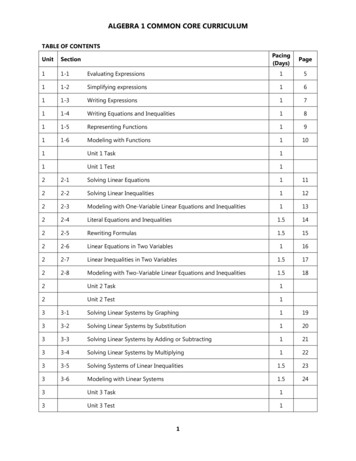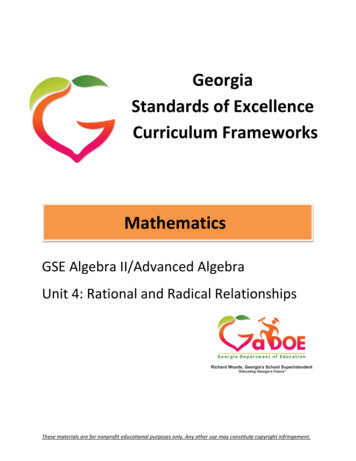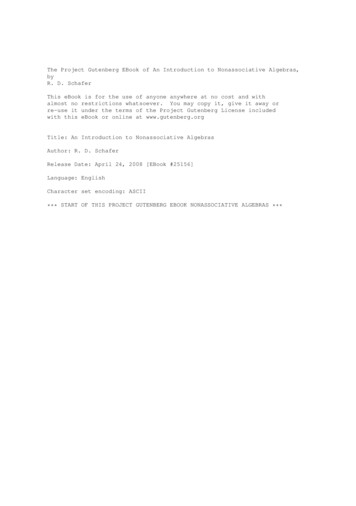
Transcription
ALGEBRA 1 COMMON CORE CURRICULUMTABLE OF CONTENTSPacing(Days)PageEvaluating Expressions151-2Simplifying expressions1611-3Writing Expressions1711-4Writing Equations and Inequalities1811-5Representing Functions1911-6Modeling with Functions1101Unit 1 Task11Unit 1 Test1UnitSection11-1122-1Solving Linear Equations11122-2Solving Linear Inequalities11222-3Modeling with One-Variable Linear Equations and Inequalities11322-4Literal Equations and Inequalities1.51422-5Rewriting Formulas1.51522-6Linear Equations in Two Variables11622-7Linear Inequalities in Two Variables1.51722-8Modeling with Two-Variable Linear Equations and Inequalities1.5182Unit 2 Task12Unit 2 Test133-1Solving Linear Systems by Graphing11933-2Solving Linear Systems by Substitution12033-3Solving Linear Systems by Adding or Subtracting12133-4Solving Linear Systems by Multiplying12233-5Solving Systems of Linear Inequalities1.52333-6Modeling with Linear Systems1.5243Unit 3 Task13Unit 3 Test11
ALGEBRA 1 COMMON CORE CURRICULUMPacing(Days)PageDiscrete Linear Functions1254-2Continuous Linear Functions12644-3Using Slope12744-4Changing the Values of m and b in f x mx b12844-5Writing Linear Functions12944-6Operations with Linear Functions13044-7Linear Functions and Their Inverses13144-8Correlations13244-9Fitting Lines to Data13344-10Linear Regression1344Unit 4 Task14Unit 4 Test1UnitSection44-1455-1Discrete Exponential Functions13555-2Exponential Growth Functions13655-3Exponential Decay Functions13755-4Changing the values of a and b in f x ab x13855-5Solving Equations Involving Exponents1.53955-6Performing Exponential Regression0.54055-7Comparing Linear and Exponential Functions14155-8Modeling with Exponential Functions1425Unit 5 Task15Unit 5 Test166-1Piecewise Functions14366-2Translating the Graph of f x x14466-3Stretching, Shrinking, and Reflecting the Graph of f x x14566-4Combining Transformations of the Graph of f x x14666-5Solving Absolute Value Equations1472
ALGEBRA 1 COMMON CORE CURRICULUMPacing(Days)PageModeling with Absolute Value Functions1486Unit 6 Task16Unit 6 Test1UnitSection66-677-1Translating the Graph of f x x 214977-2Stretching, Shrinking, and Reflecting the Graph of f x x 215077-3Combining Transformations of the Graph of f x x 215177-4Solving Quadratic Equations Graphically15277-5Solving Quadratic Equations Using Square Roots1.55377-6Modeling with Quadratic Functions1.5547Unit 7 Task17Unit 7 Test115588-1Multiplying Binomials88-2Solving x 2 bx c 0 by Factoring1.55688-3Solving ax 2 bx c 0 by Factoring1.55788-4Solving x 2 bx c 0 by Completing the Square1.55888-5Solving ax 2 bx c 0 by Completing the Square1.55988-6Deriving the Quadratic Formula16088-7Using the Quadratic Formula1.56188-8Graphing Functions of the form f x ax 2 bx c1.56288-9Solving Systems of Linear and Quadratic Equations16388-10Modeling with Quadratic Functions1648Unit 8 Task18Unit 8 Test199-1Measures of Center and Spread16599-2Data Distributions and Outliers16699-3Histograms16799-4Box Plots1683
ALGEBRA 1 COMMON CORE CURRICULUMPacing(Days)PageTwo-Way Frequency Tables1699Unit 9 Task19Unit 9 Test1UnitSection99-590Pages 70-77 list Common Core tasks linked by standard. Click on the link to access the task.NOTE: The suggested pacing has been designed for a single semester block course. For year-longcourses, apply proportional pacing.Highlighted Standards KeyPinkTN Focus Clusters (CRAs assess these)Green Major works of the gradeBlueSupporting clustersYellow Additional clusters4
ALGEBRA 1 COMMON CORE CURRICULUMUNIT 1: ALGEBRAIC MODELING AND UNIT ANALYSIS1-1Evaluating ExpressionsCCSSI StandardsN-Q.1A-SSE.1A-SSE.1aA-SSE.1bUse units as a way to understand and to guide the solutions of multi-step problems Interpret expressions that represent a quantity in terms of its context.Interpret parts of an expression, such as terms, factors, and coefficients.Interpret complicated expressions by viewing one or more of their parts as a singleentity.Mathematical PracticesPractice #7Differentiate between factors and terms. (Look for and make use of structure)Academic Vocabularyalgebraic erical expressionorder of operationstermvariableEssential QuestionHow do you interpret and evaluate algebraic expressions that model real-world situations?Skills1.2.3.4.5.6.Use the order of operations to simplify algebraic expressionsIdentify coefficientsIdentify constantsIdentify the terms of an algebraic expressionEvaluate algebraic expressionsUse unit analysis to solve problemsAlignment to Current TextbookSection 1-1 (pp.6-11), Section 1-6 (pp.40-45)NotesCommon Core assumes students can operate with integers.5
ALGEBRA 1 COMMON CORE CURRICULUMUNIT 1: ALGEBRAIC MODELING AND UNIT ANALYSIS1-2Simplifying ExpressionsCCSSI StandardsN-Q.1A-SSE.1A-SSE.1aA-SSE.2Use units as a way to understand and to guide the solutions of multi-step problems Interpret expressions that represent a quantity in terms of its context.Interpret parts of an expression, such as terms, factors, and coefficients.Use the structure of an expression to identify ways to rewrite it.Mathematical PracticesPractice #7Analyze the properties of real numbers used for simplifying expressions. (Look for andmake use of structure)Academic VocabularyCommutative Property of AdditionAssociative Property of Additionadditive identityadditive inversesCommutative Property of MultiplicationAssociative Property of Multiplicationmultiplicative identitymultiplicative inversesDistributive PropertyEssential QuestionHow can you rewrite algebraic expressions?Skills1.2.3.4.Compare expressionsUse properties to simplify expressionsIdentify propertiesSimplify expressionsAlignment to Current TextbookSection 1-7 (pp.46-51)Notes6
ALGEBRA 1 COMMON CORE CURRICULUMUNIT 1: ALGEBRAIC MODELING AND UNIT ANALYSIS1-3Writing ExpressionsCCSSI StandardsN-Q.1N-Q.2A-SSE.1A-SSE.1aA-SSE.2Use units as a way to understand and to guide the solutions of multi-step problems Define appropriate quantities for the purpose of descriptive modeling.Interpret expressions that represent a quantity in terms of its context.Interpret parts of an expression, such as terms, factors, and coefficients.Use the structure of an expression to identify ways to rewrite it.Mathematical PracticesPractice #1Translate verbal phrases into algebraic expressions so that they can be evaluatedmathematically. (Make sense of problems and persevere in solving them)Academic nquotientEssential QuestionHow do you write algebraic expressions to model quantities?Skills1.2.3.Write an algebraic expression to model a phrase.Write a phrase to model an algebraic expression.Use unit analysis to guide modeling.Alignment to Current TextbookSection 1-1 (pp.6-9)Notes7
ALGEBRA 1 COMMON CORE CURRICULUMUNIT 1: ALGEBRAIC MODELING AND UNIT ANALYSIS1-4Writing Equations and InequalitiesCCSSI StandardsN-Q.2A-CED.1A-CED.3Define appropriate quantities for the purpose of descriptive modeling.Create equations and inequalities in one variable and use them to solve problems.Represent constraints by equations or inequalities and interpret solutions as viable ornonviable options in a modeling context.Mathematical PracticesPractice #2Represent a situation symbolically and expand the solution set based upon the unitsbeing used. (Reason abstractly and quantitatively)Academic Vocabularyequationsolution of an equationinequalitysolution of an inequalityEssential QuestionHow do you represent relationships algebraically?Skills1.2.3.4.Write equations from verbal models.Solve equations from verbal models.Write inequalities from verbal models.Solve inequalities from verbal models.Alignment to Current TextbookSection 2-1 (pp.77-82), Section 3-1 (pp.170-175)Notes8
ALGEBRA 1 COMMON CORE CURRICULUMUNIT 1: ALGEBRAIC MODELING AND UNIT ANALYSIS1-5Representing FunctionsCCSSI StandardsN-Q.1F-IF.1Choose and interpret the scale and the origin in graphs and data displays.Understand that a function from one set (called the domain) to another set (called therange) assigns to each element of the domain exactly one element of the range. If f is afunction and x is an element of its domain, then f x denotes the output of fcorresponding to the input x. The graph of f is the graph of the equation y f x .F-IF.2Use function notation, evaluate functions for inputs in their domains, and interpretstatements that use function notation in terms of a context.Relate the domain of a function to its graph and, where applicable, to the quantitativerelationship it describes.F-IF.5Mathematical PracticesPractice #2Analyze inputs and outputs and their associated units. (Reason abstractly andquantitatively)Academic Vocabularyfunctiondomainrangefunction notationindependent variabledependent variablefunction ruleEssential QuestionHow do you represent functions?Skills1.2.Write the domain and range of a function.Represent functions as equations, tables of values, and graphs.Alignment to Current TextbookSection 1-8 (pp.54-59)Notes9
ALGEBRA 1 COMMON CORE CURRICULUMUNIT 1: ALGEBRAIC MODELING AND UNIT ANALYSIS1-6Modeling with FunctionsCCSSI StandardsN-Q.1A-CED.1F-IF.1Choose and interpret the scale and the origin in graphs and data displays.Create equations in one variable and use them to solve problems.Understand that a function from one set (called the domain) to another set (called therange) assigns to each element of the domain exactly one element of the range. If f is afunction and x is an element of its domain, then f x denotes the output of fcorresponding to the input x. The graph of f is the graph of the equation y f x .F-IF.2Use function notation, evaluate functions for inputs in their domains, and interpretstatements that use function notation in terms of a context.Relate the domain of a function to its graph.Write a function that describes a relationship between two quantities.Determine an explicit expression from a context.F-IF.5F-BF.1F-BF.1.aMathematical PracticesPractice #3Summarize findings and comment on the clarity and completeness of the findings forpaying off a loan using a function. (Construct viable arguments and critique thereasoning of others)Academic Vocabularyfunctiondomainrangefunction notationindependent variabledependent variablefunction ruleEssential QuestionHow can you model paying off a loan using a function?Skills1.2.3.Write a function rule from given information.Make a table and a graph to represent a function.Analyze a function model.Alignment to Current TextbookSection 1-8 (pp.54-59)Notes10
ALGEBRA 1 COMMON CORE CURRICULUMUNIT 2: LINEAR EQUATIONS AND INEQUALITIES2-1Solving Linear EquationsCCSSI StandardsA-SSE.2A-REI.1Use the structure of an expression to identify ways to rewrite it.Explain each step in solving a simple equation as following from the equality of numbersasserted at the previous step, starting from the assumption that the original equationhas a solution. Construct a viable argument to justify a solution method.Solve linear equations.Use function notation, evaluate functions for inputs in their domains, and interpretstatements that use function notation in terms of a context.A-REI.3F-IF.2Mathematical PracticesPractice #3Recognize that finding the values such that two functions are equal uses the skills ofsolving an equation Justifications should involve the properties of equality and otherproperties. Show that the solution is correct by checking the values in the originalfunction. (Construct viable arguments and critique the reasoning of others)Academic Vocabularyequivalent equationsAddition Property of EqualitySubtraction Property of EqualityMultiplication Property of EqualityDivision Property of EqualityEssential QuestionHow can you use the properties of equality to support your solution to a linear equation?Skills1.2.3.Solve a one-step linear equation.Solve a multi-step linear equation.Determine equality of functions where f x g x .Alignment to Current TextbookSection 2-1 (pp.77-82), Section 2-2 (pp.84-90), Section 2-3 (pp.92-98), Section 2-4 (pp.100-106)Notes11
ALGEBRA 1 COMMON CORE CURRICULUMUNIT 2: LINEAR EQUATIONS AND INEQUALITIES2-2Solving Linear InequalitiesCCSSI StandardsA-SSE.2A-REI.1Use the structure of an expression to identify ways to rewrite it.Explain each step in solving a simple equation as following from the equality of numbersasserted at the previous step, starting from the assumption that the original equationhas a solution. Construct a viable argument to justify a solution method.Solve linear equations.Use function notation, evaluate functions for inputs in their domains, and interpretstatements that use function notation in terms of a context.A-REI.3F-IF.2Mathematical PracticesPractice #7Recognize that the properties of equality and the properties of inequalities arestructured in the same way. (Look for and make use of structure)Academic VocabularyAddition Property of InequalitySubtraction Property of InequalityMultiplication Property of InequalityDivision Property of InequalityEssential QuestionHow do you justify the solution to a linear inequality?Skills1.2.3.4.Justify the solution of an inequality.Solve a multi-step linear inequality.Represent the solution set of an inequality in set-builder form and on a number line.Determine inequality of functions where f x g x .Alignment to Current TextbookSection 3-1 (pp.170-175), Section 3-2 (pp.176-181), Section 3-3 (pp.182-187), Section 3-4 (pp.190-195),Section 3-5 (pp.196-202)NotesInclude compound inequalities12
ALGEBRA 1 COMMON CORE CURRICULUMUNIT 2: LINEAR EQUATIONS AND INEQUALITIES2-3Modeling with One-Variable Linear Equations and InequalitiesCCSSI StandardsN-Q.1Use units as a way to understand and to guide the solutions of multi-step problems;choose and interpret units consistently in formulas Define appropriate quantities for the purpose of descriptive modeling.Create equations and inequalities in one variable and use them to solve problems.Create equations in two or more variables to represent relationships between quantities.Represent constraints by equations or inequalities and interpret solutions as viable ornonviable options in a modeling context.Write a function that describes a relationship between two quantities.Interpret expressions that represent a quantity in terms of its context.Relate the domain of a function to its 5Mathematical PracticesPractice #3Exchange summaries and comment on the clarity and completeness of the argumentmade by other students concerning a diet and exercise plan. (Construct viable argumentsand critique the reasoning of others)Academic VocabularyNo new vocabularyEssential QuestionHow can you use linear equations and inequalities to analyze a weight-loss plan?Skills1.2.Model a real-world situation with a linear equation.Model a real-world situation with a linear inequality.Alignment to Current TextbookVarious problems from pp.77-106 and pp.170-202, Section 11-4 (pp.813-819)NotesSee specific example problems on pages 76,79,86,94-95,102,172,177-178,184,192,19713
ALGEBRA 1 COMMON CORE CURRICULUMUNIT 2: LINEAR EQUATIONS AND INEQUALITIES2-4Literal Equations and InequalitiesCCSSI StandardsA-REI.1Explain each step in solving a simple equation as following from the equality of numbersasserted at the previous step, starting from the assumption that the original equationhas a solution. Construct a viable argument to justify a solution method.Solve linear equations.A-REI.3Mathematical PracticesPractice #6Placing a restriction on the coefficient(s) of the variable in a literal equation or inequalityhelps to generalize a class of equations or inequalities because it guarantees that theliteral equation or inequality will have a variable term and determines what happens tothe inequality sign when solving a literal inequality. (Attend to precision)Academic Vocabularyliteral equationliteral inequalityEssential QuestionHow do you solve literal equations and inequalities?Skills1.2.Solve literal equations for a specified variable.Solve literal inequalities for a specified variable.Alignment to Current TextbookSection 2-5 (pp.107-111)Notes14
ALGEBRA 1 COMMON CORE CURRICULUMUNIT 2: LINEAR EQUATIONS AND INEQUALITIES2-5Rewriting FormulasCCSSI StandardsA-CED.2Create equations in two or more variables to represent relationships betweenquantities Rearrange formulas to highlight a quantity of interest, using the same reasoning as insolving equations Use geometric shapes, their measures, and their properties to describe objects.A-CED.4G-MG.1Mathematical PracticesPractice #4Rewriting a formula for the area of a square in terms of its perimeter can be modeled bya fenced-in piece of land. (Model with mathematics)Academic VocabularyNo new vocabularyEssential QuestionHow do you rewrite formulas?Skills1.2.Solve a formula for a specified variable.Write and rearrange formulas.Alignment to Current TextbookSection 2-5 (pp.107-111)Notes15
ALGEBRA 1 COMMON CORE CURRICULUMUNIT 2: LINEAR EQUATIONS AND INEQUALITIES2-6Linear Equations in Two VariablesCCSSI StandardsA-REI.10Understand that the graph of an equation in two variables is the set of all its solutionsplotted in the coordinate plane, often forming a curve (which could be a line).Mathematical PracticesPractice #7Intercepts are easy to find and are sufficient to identify the line through the remainingpoints. (Look for and make use of structure)Academic Vocabularylinear equation in two variablesstandard form of a linear equationsolution of an equation in two variablesx-intercepty-interceptEssential QuestionHow do you graph the solutions to a linear equation in two variables?Skills1.2.3.4.Determine whether on ordered pair is a solution.Graph a linear equation in standard form.Graph vertical and horizontal lines.Graph lines through the origin.Alignment to Current TextbookSection 4-4 (pp.256-262), Section 5-1 (pp.300-306), Section 5-2 (pp.307-312)Notes16
ALGEBRA 1 COMMON CORE CURRICULUMUNIT 2: LINEAR EQUATIONS AND INEQUALITIES2-7Linear Inequalities in Two VariablesCCSSI StandardsA-REI.12Graph the solutions to a linear inequality in two variables as a half-plane (excluding theboundary in the case of a strict inequality) Mathematical PracticesPractice #7Graph the boundary line of a linear inequality in two variables and use a test point toidentify the half-plane of the solution set. (Look for and make use of structure)Academic Vocabularylinear inequality in two variablessolution of an inequality in two variablesEssential QuestionHow do you graph a linear inequality in two variables?Skills1.Graph a linear inequality in two variables.Alignment to Current TextbookSection 6-5 (pp.428-434)Notes17
ALGEBRA 1 COMMON CORE CURRICULUMUNIT 2: LINEAR EQUATIONS AND INEQUALITIES2-8Modeling with Two-Variable Linear Equations and InequalitiesCCSSI StandardsN-Q.1Use units as a way to understand and to guide the solutions of multi-step problems;choose and interpret units consistently in formulas Define appropriate quantities for the purpose of descriptive modeling.Interpret expressions that represent a quantity in terms of its context.Create equations in two or more variables to represent relationships betweenquantities Represent constraints by equations or inequalities and interpret solutions as viable ornonviable options in a modeling context.N-Q.2A-SSE.1A-CED.2A-CED.3Mathematical PracticesPractice #5Discuss how, for instance, the sales of t-shirts and blankets are ordered pairs that can begraphed and that these ordered pairs meet a particular sales goal on the line, while theordered pairs that meet a minimum sales goal lie in a half-plane. (Model withmathematics)Academic VocabularyNo new vocabularyEssential QuestionHow can you use linear equations and inequalities to model the results of a fundraiser?Skills1.2.Model and graph a real-world situation with a linear equation in two variables.Model and graph a real-world situation with a linear inequality in two variables.Alignment to Current TextbookVarious problems from pp.256-262,300-312,428-434, Section 11-4 (pp.813-819)NotesSee specific problems on pages 259,303,43018
ALGEBRA 1 COMMON CORE CURRICULUMUNIT 3: SYSTEMS OF EQUATIONS AND INEQUALITIES3-1Solving Linear Systems by GraphingCCSSI StandardsA-REI.6Solve systems of linear equations approximately (e.g. with graphs), focusing on pairs oflinear equations in two variables.Mathematical PracticesPractice #5Look at the intersections of two lines to approximate the solution of the system usingvisual tools. Adjust graph scales as necessary for more accurate estimations. Recognizewhen the solution is exact. (Use appropriate tools strategically)Academic Vocabularysystem of linear equationssolution of a system of linear equationsEssential QuestionHow do you approximate the solution of a system of linear equations by graphing?Skills1.2.3.Solve systems of equations by graphing.Estimate the solution of a system of equations by graphing.Determine if a system of linear equations has one solution, no solution, or infinitely manysolutions.Alignment to Current TextbookSection 6-1 (pp.397-402)Notes19
ALGEBRA 1 COMMON CORE CURRICULUMUNIT 3: SYSTEMS OF EQUATIONS AND INEQUALITIES3-2Solving Linear Systems by SubstitutionCCSSI StandardsA-REI.6Solve systems of linear equations exactly , focusing on pairs of linear equations in twovariables.Mathematical PracticesPractice #7When using substitution, look for structure when examining the system and identify thevariable that is easier to isolate. Rewrite one equation so that one variable is isolated onone side of the equation and an equivalent expression containing the other variable ison the other side. (Look for and make use of structure)Academic Vocabularysubstitution methodEssential QuestionHow do you use substitution to solve a system of linear equations?Skills1.2.Solve systems of equations using the substitution method.Determine if a system of linear equations has one solution, no solution, or infinitely manysolutions.Alignment to Current TextbookSection 6-2 (pp.404-410), Section 6-4 (pp.420-425)Notes20
ALGEBRA 1 COMMON CORE CURRICULUMUNIT 3: SYSTEMS OF EQUATIONS AND INEQUALITIES3-3Solving Linear Systems by Adding or SubtractingCCSSI StandardsA-REI.6Solve systems of linear equations exactly , focusing on pairs of linear equations in twovariables.Mathematical PracticesPractice #8When solving a system of linear equations by adding or subtracting, notice that linearsystems with equations that have like terms with coefficients that are additive inversescan be solved by adding and that those that have identical terms can be solved bysubtracting. (Look for and express regularity in repeated reasoning)Academic Vocabularyelimination methodEssential QuestionHow do you solve a system of linear equations by adding or subtracting?Skills1.2.Solve systems of equations by adding or subtracting.Determine if a system of linear equations has one solution, no solution, or infinitely manysolutions.Alignment to Current TextbookSection 6-3 (pp.411-417), Section 6-4 (pp.420-425)Notes21
ALGEBRA 1 COMMON CORE CURRICULUMUNIT 3: SYSTEMS OF EQUATIONS AND INEQUALITIES3-4Solving Linear Systems by MultiplyingCCSSI StandardsA-REI.5Prove that, given a system of two equations in two variables, replacing one equation bythe sum of that equation and a multiple of the other produces a system with the samesolutions.Solve systems of linear equations exactly , focusing on pairs of linear equations in twovariables.A-REI.6Mathematical PracticesPractice #3Show by graphing that given a system of two equations in two variables, replacing oneequation by the sum of that equation and a multiple of the other produces a system withthe same solutions. Move from concrete representations to the more abstract algebraicproof. (Construct viable arguments and critique the reasoning of others)Academic Vocabularyelimination methodEssential QuestionHow do you solve a system of linear equations by multiplying?Skills1.2.Solve systems of equations by multiplying.Determine if a system of linear equations has one solution, no solution, or infinitely manysolutions.Alignment to Current TextbookSection 6-3 (pp.411-417), Section 6-4 (pp.420-425)Notes22
ALGEBRA 1 COMMON CORE CURRICULUMUNIT 3: SYSTEMS OF EQUATIONS AND INEQUALITIES3-5Solving Systems of Linear InequalitiesCCSSI StandardsA-REI.12Graph the solutions to a linear inequality in two variables as a half-plane (excluding theboundary in the case of a strict inequality), and graph the solution set to a system oflinear inequalities in two variables as the intersection of the corresponding half-planes.Mathematical PracticesPractice #7When solving a system of linear inequalities in two variables, build upon the strategies ofsolving compound inequalities in one variable and graphing a linear inequality in twovariables. Use boundary lines and test points to determine the solution of the system.(Look for and make use of structure)Academic Vocabularysystem of linear inequalitiessolutions of a system of linear inequalitiesEssential QuestionHow do you solve a system of linear inequalities?Skills1.2.Solve systems of linear inequalities by graphing.Describe the solutions of a system of linear inequalities.Alignment to Current TextbookSection 6-6 (pp.435-440)Notes23
ALGEBRA 1 COMMON CORE CURRICULUMUNIT 3: SYSTEMS OF EQUATIONS AND INEQUALITIES3-6Modeling with Linear SystemsCCSSI e units as a way to understand problems and to guide the solution of multi-stepproblems; choose and interpret units consistently Define appropriate quantities for the purpose of descriptive modeling.Create equations in two or more variables to represent relationships betweenquantities Represent constraints by equations or inequalities, and by systems of equations and/orinequalities, and interpret solutions as viable or nonviable options in a modeling context.Solve systems of linear equations exactly , focusing on pairs of linear equations in twovariables.Graph the solutions to a linear inequality in two variables as a half-plane (excluding theboundary in the case of a strict inequality), and graph the solution set to a system oflinear inequalities in two variables as the intersection of the corresponding half-planes.Mathematical PracticesPractice #4Construct algebraic and graphical models of real-world situations. Show how changingthe conditions of a situation affect the graphical model. Stress importance of checkingthe model with different values, including values on the boundary line. (Model withmathematics)Academic VocabularyNo new vocabularyEssential QuestionHow can you use systems of linear equations or inequalities to model and solve contextual problems?Skills1.2.Model systems of linear equations.Model systems of linear inequalities.Alignment to Current TextbookSee specific example problems on pages 399,403,407,414,422,430,437Notes24
ALGEBRA 1 COMMON CORE CURRICULUMUNIT 4: LINEAR FUNCTIONS4-1Discrete Linear FunctionsCCSSI StandardsF-IF.2Use function notation, evaluate functions for inputs in their domains, and interpretstatements that use function notation in terms of a context.Recognize that sequences are functions, sometimes defined recursively, whose domain isa subset of the integers.Relate the domain of a function to its graph and, where applicable, to the quantitativerelationship it describes.Graph functions expressed symbolically and show key features of the graph, by hand insimple cases and using technology for more complicated cases.Graph linear functions and show intercepts Write arithmetic sequences with an explicit formula, use them to model situations F-IF.3F-IF.5F-IF.7F-IF.7aF-BF.2Mathematical PracticesPractice #7Show how linear functions arise naturally from the structure of arithmetic sequences.(Look for and make use of structure)Academic Vocabularylinear functionEssential QuestionWhat are the characteristics of a discrete linear function?Skills1.2.Graph discrete real-world functions.Identify the domain and range of discrete real-world functions.Alignment to Current TextbookSection 5-1 (pp.300-306)NotesArithmetic sequences are on HMH pp.276-28125
ALGEBRA 1 COMMON CORE CURRICULUMUNIT 4: LINEAR FUNCTIONS4-2Continuous Linear FunctionsCCSSI StandardsN-Q.1Use units as a way to understand problems and to guide the solution of multi-stepproblems; choose and interpret the scale and the origin in graphs and data displays.Understand that a function from one set (called the domain) to another set (called therange) assigns to each element of the domain exactly one element of the range. If f is afunction and x is an element of its domain, then f x denotes the output of fF-IF.1corresponding to the input x. The graph of f is the graph of the equation y f x .F-IF.2Use function notation, evaluate functions for inputs in their domains, and interpretstatements that use function notation in terms of a context.Relate the domain of a function to its graph and, where applicable, to the quantitativerelationship it describes.Compare properties of two functions each represented in a different way (algebraically,graphically, numerically in tables, or by verbal descriptions).F-IF.5F-IF.9Mathematical PracticesPractice #2Compare the description of a heavy storm by a graph of a violent storm to help visualizehow to represent the heavy storm graphically (time in hours vs. rainfall in inches).(Reason abstractly and quantitatively)Academic Vocabularylinear functionEssential QuestionHow are discrete and continuous linear functions alike, and how are they different?Skills1.2.Graph continuous real-world functions.Identify the domain and range of continuous real-world functions.Alignment to Current TextbookSection 5-1 (pp.300-306)Notes26
ALGEBRA 1 COMMON CORE CURRICULU
ALGEBRA 1 COMMON CORE CURRICULUM 6 UNIT 1: ALGEBRAIC MODELING AND UNIT ANALYSIS 1-2 Simplifying Expressions CCSSI Standards N-Q.1 Use units as a way to understand and to guide the solutions of multi-step problems A-SSE.1 Interpret expressions that represent a quantity in terms of its context.











